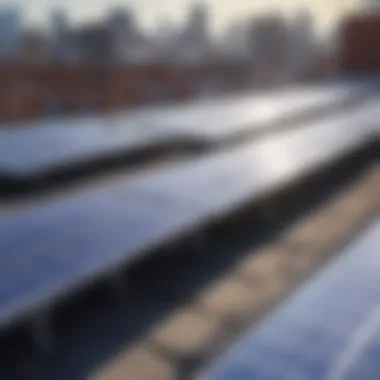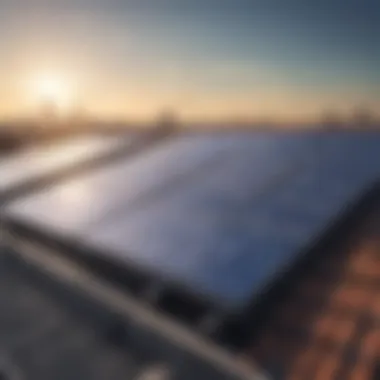Top Rooftop Solar Panels: Efficiency and Value


Intro
As the sun bathes our rooftops daily, harnessing solar energy has evolved into more than a trend; it’s now a viable investment opportunity. Homeowners and businesses are increasingly exploring rooftop solar panels, not just for their environmental benefits, but for their potential to lower energy costs and increase property value. However, navigating the landscape of rooftop solar options can seem daunting. This guide aims to demystify the process, shedding light on essential terminology, technology options, installation procedures, and financial aspects to consider.
Investment Terminology Breakdown
Key Terms Explained
While solar energy might seem straightforward, the jargon surrounding it can make your head spin. Let’s sort through some key terms that may come up:
- Photovoltaic (PV) Cells: These are the heart of solar panels, converting sunlight into electricity.
- Inverter: This device converts the direct current (DC) electricity produced by solar panels into alternating current (AC), which is used by most household appliances.
- Net Metering: A billing mechanism allowing solar energy users to get credited for any excess energy they generate and feed back into the grid.
- Solar Lease: A contract allowing individuals to utilize solar panels without the upfront costs of purchase, paying instead for the energy produced.
It's vital to become familiar with these terms to feel confident in making informed decisions.
Common Misconceptions in Investing
Many assume that solar energy is only for the eco-conscious or tech-savvy. Here are some prevalent misconceptions:
- It's Too Expensive: While initial costs can be high, incentives and decreased prices over the years significantly lessen this burden. In fact, many states offer tax credits or rebates that sweeten the deal.
- They're Not Effective in Cloudy Areas: Believe it or not, solar panels can generate energy even on cloudy days. Their efficiency may vary, but production isn’t solely dependent on direct sunlight.
- Maintenance is a Headache: In reality, solar panels require minimal upkeep. Regular cleaning and occasional inspections are generally enough to keep them running smoothly.
Understanding these misconceptions helps investors gauge the true potential of rooftop solar panels.
Financial Product Reviews
Evaluating financial products related to solar energy is crucial for anyone considering an investment.
In-Depth Product Analysis
When it comes to financing options, several products stand out:
- Solar Loans: Institutions like LightStream provide loans specifically for solar installations, typically at competitive interest rates. This gives homeowners flexibility with payments without having to commit to a full purchase upfront.
- Power Purchase Agreements (PPAs): Here, users pay for the power generated rather than the solar system itself. This can often mean no upfront costs, but it is crucial to understand the terms, as rates can vary.
- Federal and State Incentives: Programs like the Federal Investment Tax Credit (ITC) can significantly reduce the cost of installation. Homeowners can reclaim a portion of the expenses when they file their taxes.
Pros and Cons of Each Offering
Each financial option comes with its benefits and drawbacks:
- Solar Loans:
- PPAs:
- Incentives:
- Pros: Ownership of the system, potential for tax credits.
- Cons: Monthly payments, which may strain budgets.
- Pros: No upfront costs, predictable billing.
- Cons: Less control over the system, potential for price increases over time.
- Pros: Major financial aid reducing investment costs.
- Cons: Complex application processes and deadlines to keep track of.
Understanding Solar Energy
Understanding the fundamentals of solar energy is crucial when diving into the world of rooftop solar panels. This knowledge not only lays the groundwork for appreciating how these systems work but also helps consumers to grasp the many advantages they offer in terms of sustainability and cost savings. Solar energy refers to the energy that is harnessed from sunlight, which can be converted into electricity or heat. This simple yet transformative concept underlies the entire solar power industry, fueling everything from small residential systems to large-scale solar farms.
The importance of understanding solar energy lies in its direct environmental and economic benefits. Switching to solar power can drastically reduce one’s carbon footprint, thus contributing to a healthier planet. In addition, solar panels typically lower electricity bills and can even enhance a property’s value. It's a win-win situation for homeowners and for the environment alike.
Moreover, as global energy needs evolve and the quest for sustainable solutions intensifies, comprehending solar energy becomes ever more relevant. As technology advances, knowing the latest developments will enable consumers to make informed choices about their energy solutions, ensuring they invest wisely.
The Concept of Solar Power
Solar power is generated through the capture of sunlight, which is one of the most abundant resources available. At its core, solar energy production involves converting sunlight into electricity using two common methods: photovoltaics and solar thermal energy. Photovoltaics actually convert sunlight directly into electricity via solar panels, while solar thermal systems focus on using sunlight to produce heat that can then generate electricity.
This simplicity in concept juxtaposed to the intricate systems behind it can often confuse those new to solar. Yet, simplistically spoke, harnessing the sun's rays into usable energy is at the heart of solar technology. Solving energy efficiency issues while fulfilling climate goals is vital, further emphasizing the value of developing an understanding of solar energy.
Environmental Benefits
The environmental benefits of solar energy are substantial, making it a pivotal topic in the global conversation about sustainable living. Embracing solar power means mitigating the reliance on fossil fuels, which generates harmful emissions that contribute to climate change. By utilizing solar panels, individuals and companies can significantly cut down on greenhouse gas emissions.
Some key environmental advantages include:
- Reduction in Air Pollution: Solar energy generates electricity without emitting harmful pollutants.
- Conservation of Water: Unlike traditional energy sources, solar power requires minimal water for operation.
- Biodiversity Protection: Transitioning to solar energy allows for the reduction of land degradation and habitat loss that often accompany fossil fuel extraction.
Investing in solar energy not only supports personal needs but also contributes to the stewardship of the planet. It encourages a cleaner environment for future generations while helping to promote awareness about climate issues.
Key Terminology
Understanding the terminology associated with solar energy can significantly streamline the process of evaluating solar panels. Essential terms to know include:
Photovoltaic Cells
Photovoltaic cells are the cornerstone of solar panel technology. These are the components that convert sunlight into electricity. The most popular material used in these cells is silicon, recognized for its efficiency in energy conversion.
The key characteristic of photovoltaic cells is their ability to generate electricity in direct response to sunlight. This unique feature is what positions them as such a beneficial choice for solar solutions.
However, photovoltaic cells also come with disadvantages: they require efficient installation angles and can be less effective under low light conditions.
Grid-Tied vs. Off-Grid
Understanding the difference between grid-tied and off-grid systems is vital when considering how to harness solar energy. Grid-tied systems are connected to the electrical grid and allow surplus solar electricity to be sent back, often benefiting from net metering, whereas off-grid systems operate independently, relying solely on stored solar energy.
Grid-tied systems are popular for their ability to lower electricity costs without battery storage, while off-grid systems ensure energy independence but can involve higher initial costs due to battery installation.
Net Metering
Net metering is a billing mechanism that allows solar energy users to get credit for the excess electricity they generate. Essentially, when solar panels generate more electricity than needed, the surplus is sent to the grid, and users are credited for it on their energy bills.


This key characteristic makes net metering a desirable choice for homeowners and businesses, as it can significantly reduce energy costs. However, potential disadvantages include varying net metering policies that can differ by location and utility, affecting overall savings.
Types of Rooftop Solar Panels
When considering investment in solar technology, understanding the different types of rooftop solar panels is imperative. Each type offers unique benefits and drawbacks that can influence not only the upfront costs but also long-term savings and efficiency. Knowing the distinctions among these panels can provide clarity when making a decision aligned with your energy needs and budget. There are mainly three types of rooftop solar panels: monocrystalline, polycrystalline, and thin-film. Each brings a different flavor of utility to the table, making it essential to weigh the pros and cons before diving in.
Monocrystalline Panels
Monocrystalline panels are made from a single crystal structure, which is forged into a silicon wafer. This singular genesis gives these panels a distinctive black hue and a high power output, making them a top choice amongst consumers.
Advantages
The efficiency of monocrystalline panels is among the highest on the market, typically ranging between 15% to 22%. This means that for a given area, they can produce more electricity than their counterparts. Such efficiency can lead to long-term savings on energy bills and a quicker return on investment. The space-saving nature of these panels is a reason why many homeowners opt for them, especially if there’s limited roof space.
A standout feature is their longevity. Many brands offer warranties of 25 years or more, which speaks volumes about their durability and reliability. An edge here is the aesthetic appeal; the sleek, uniform design often attracts homeowners who value both function and form in their solar choice.
Disadvantages
On the flip side, monocrystalline panels come with a hefty price tag. The manufacturing process demand more time and resources, pushing the costs up compared to other solar panels. Not everyone is ready to fork out considerably more cash at the start, even if the savings over time can be significant.
Moreover, their performance can decline in high temperatures. While they are efficient, excessive heat can impact their output. This aspect may make homeowners in hotter climates reconsider their options if potential efficiency losses weigh heavily on their decision-making process.
Polycrystalline Panels
Polycrystalline panels are made from multiple silicon crystals melted together. They usually have a bluish hue and are often less expensive to produce than their monocrystalline counterparts.
Advantages
The most enticing aspect of polycrystalline panels is their affordability. Their lower production cost means that they can often offer a cheaper entry point to solar energy, making them accessible for more homeowners. Also, while not as efficient as monocrystalline panels, polycrystalline models still boast an efficiency range of around 13% to 16%, which is quite respectable for many installations.
Another perk is they tend to handle heat better than monocrystalline panels. This characteristic means they often maintain integrity through warmer months, offering consistent performance where monocrystalline might falter.
Disadvantages
However, as is often the case, lower upfront costs equate to some compromises. The efficiency of polycrystalline panels is not up to par with monocrystalline ones, which can lead to requiring a larger array to generate the same amount of power. This aspect could be a dealbreaker if roof space is at a premium.
Additionally, they generally have a shorter lifespan compared to monocrystalline, with warranties typically around 20 years. While this is still substantial, it may not inspire as much confidence in long-term reliance.
Thin-Film Panels
Thin-film panels differ significantly from crystalline types, as they are made by depositing layers of photovoltaic material on a variety of substrates. They are lightweight and flexible, making them versatile for various applications.
Advantages
Thin-film panels have a notable advantage in their weight and flexibility, which allows for installation on surfaces where traditional panels may not be feasible, like curved roofs or even portable structures. They also perform better in shaded conditions and high temperatures than the more rigid options.
The affordability factor is also appealing; thin-film panels are often cheaper to manufacture and install. This could be important for homeowners looking to minimize upfront investments without sacrificing solar energy production.
Disadvantages
On the downside, thin-film panels tend to have the lowest efficiency ratings, usually falling within 10% to 12%. This means many homeowners might have to deal with a larger array to achieve comparable outputs to crystalline options. That might negate the benefits of their flexibility in terms of installation ease.
Furthermore, the technology is relatively newer, which can yield less reliable performance histories and warranties. It is not uncommon for these panels to face skepticism as the technology evolves.
Overall, knowing the varieties of rooftop solar panels and their respective strengths and weaknesses is crucial. Making a thoughtful choice, tailored to your specific circumstances, can significantly impact both upfront costs and long-term energy savings.
Evaluating Efficiency and Performance
In the realm of rooftop solar panels, evaluating efficiency and performance is akin to measuring the pulse of an evolving technology. It's crucial to understand how well panels capture sunlight and convert it into usable energy. This evaluation reflects not just the initial cost but also long-term savings, environmental impact, and overall energy independence. In this section, we will break down the factors that contribute to performance, allowing potential investors and energy-conscious consumers to navigate this complex landscape with ease.
Efficiency Ratings Explained
When it comes to solar panels, efficiency ratings can feel like a maze of numbers, but they are essential for determining how well a panel converts sunlight. The efficiency of solar panels, typically expressed as a percentage, indicates the portion of sunlight that can be transformed into usable electricity. For instance, if a panel has an efficiency rating of 20%, it means that 20% of the sunlight hitting it is converted into power.
High-efficiency panels generally yield more electricity from the same amount of sunlight. However, it's not just about the efficiency #; per watt produced, the cost of installation plays a pivotal role in overall value. Consideration must be given to:
- Type of Panel: Different technologies offer varying efficiencies. For example, monocrystalline panels typically boast higher efficiencies, often around 22-26%.
- Installation Quality: Poor installation can hamper performance, regardless of the panel's efficiency rating.
- Match with Energy Needs: Understanding household or business energy consumption patterns is fundamental. If a panel is highly efficient but the energy needs are low, it may not be necessary.
Impact of Temperature and Weather
Temperature and weather conditions significantly affect the performance of solar panels. Solar technology generally works efficiently in moderate temperatures; however, there's a decline in output as temperatures soar. Interestingly, while panels are designed to harness sunlight, excessive heat can diminish their efficacy.
Think of it this way: during a scorching summer day, the efficiency of solar panels can drop by 10% or more. Additionally, geographical factors also play into this. Areas with frequent cloud cover may impact energy generation differently than sunnier locales. Key considerations include:
- Local Climate: The long-term weather patterns in your region will dictate the overall performance of solar panels.
- Installation Elevation: Panels installed at angles may benefit more from sunlight exposure and less affected by debris like leaves or snow, thus improving efficiency.
- Temperature Specifications: Check the temperature coefficient of your solar panels. This figure indicates how much the efficiency drops with temperature increases.
Real-World Performance Metrics
When the rubber meets the road, real-world performance metrics offer a perspective that efficiency ratings alone cannot provide. These metrics give insights into how solar panels perform under practical conditions:
- Energy Output Analysis: Monitoring systems can track daily and seasonal energy output, providing clear visibility into performance.
- Durability Tests: Years after installation, how do panels hold up? Aging tests and weather resistance trials are important for understanding long-term reliability.
- Return on Investment (ROI): Evaluating performance through the lens of ROI can help gauge financial viability. Look at how energy savings stack against your initial investment over years.
"Understanding efficiency isn’t just about the numbers; it’s about aligning technology with your energy objectives and lifestyle choices."
By evaluating these performance factors, consumers can confidently make informed decisions about which solar panels will work best for their unique situations, thereby maximizing both energy production and financial returns.
Choosing the Right Rooftop Solar Panel
Selecting the right rooftop solar panel is a pivotal step in harnessing solar energy efficiently. With a myriad of options available, each varying in performance, efficiency, and cost, the decision can feel overwhelming. However, focusing on specific elements can simplify the process and lead you to an informed choice that aligns with your energy needs, space considerations, and long-term expectations. This section will lay out the essential criteria to help you make a knowledgeable decision in your solar investment.
Assessing Your Energy Needs


The first step in choosing the appropriate rooftop solar panels is to thoroughly assess your energy needs. Consider how much electricity your household or business utilizes regularly. A comprehensive understanding of your current consumption can help pinpoint how much solar energy is necessary for your setup. Here’s how you can break it down:
- Identify Monthly Energy Use: Look at your utility bills over the past year, and discern monthly trends. This will provide a solid average of your kilowatt-hour usage.
- Project Future Needs: If you plan on expanding your family or increasing your business's operational hours, factor in potential future growth into your calculations.
- Design a Solar System: Generally, you want a solar panel system that can generate sufficient power to offset your energy bills. A good rule of thumb is that 1 kilowatt of installed solar can produce roughly 1,200 to 1,500 kWh per year, depending on your location.
Understanding these factors not only helps you to narrow down the type of solar panel you need but also informs you about the overall size and capacity of the system required.
Consideration of Space and Orientation
Once you grasp your energy requirements, the next critical factor relates to your roof's space and orientation. Not every rooftop is ideal for solar panel installation. Factors to consider include:
- Available Roof Area: Check if your roof can accommodate the panels needed to meet your energy needs. Sometimes, adding additional panels may not be feasible if the space is limited.
- Roof Orientation: South-facing roofs typically receive the most sunlight, increasing potential energy production. An east or west orientation can still work but may produce less energy throughout the day.
- Shading Issues: Inspect your roof for shading from trees, buildings, or other obstructions that can block sunlight. Even partial shading can significantly degrade the efficiency of solar panels. While technology has improved to mitigate these issues with microinverters and power optimizers, it's still something to consider early on.
By evaluating these aspects, you can make more educated choices about the type and number of panels, ensuring your investment maximizes energy production.
Analyzing Warranty and Lifespan
Another paramount aspect that deserves attention when selecting solar panels is warranty and lifespan. This factor ties directly to the financial implications of your investment. When considering warranties, look for:
- Product Warranty: Most reputable solar panel manufacturers offer a product warranty ranging from 10 to 25 years. This protects you against defects or significant drop in performance.
- Power Warranty: This usually assures that the panels will produce a certain amount of power (like 80% of the initial output) for a specific period, often 25 years.
- Longevity and Degradation Rate: Research the expected lifespan of the solar panels you are considering. Quality panels typically have a slow degradation rate, dropping around 0.5% to 1% in efficiency per year. This translates into better performance over time.
A proper understanding of warranties gives you peace of mind that your system will last and perform efficiently, making it a crucial aspect of your decision-making process.
"Solar power isn't just about saving money; it's an investment in a sustainable future. A well-chosen panel today can pay dividends for decades to come."
By being diligent about assessing your energy needs, evaluating your roof, and understanding warranties, you set the stage for a successful transition to solar energy.
Installation Process Overview
The installation of rooftop solar panels is a significant step in harnessing solar energy. This process is not merely about placing panels on a roof; it involves a series of essential procedures that ensure optimal performance and integration with existing energy systems. Understanding this process helps potential buyers not only in planning but also in managing expectations about time frames, costs, and necessary permissions.
When considering solar energy, the installation should not be treated as an afterthought. It is integral to the entire investment. Proper installation maximizes efficiency, prolongs the life of the system, and ensures compliance with local regulations. Overlooking the finer details in this phase may lead to complications that could have been easily avoided.
Finding a Qualified Installer
The first step in the installation process is finding a competent installer. A qualified professional plays a pivotal role in ensuring that the solar system functions effectively and safely. Not all installers possess the same level of expertise, so it's crucial to do thorough research.
Start by seeking referrals from friends, family, or online communities focusing on solar energy. Websites like reddit.com have active discussions that can provide valuable insights and recommendations. Verify their credentials, including licenses and certifications relevant to your region. Additionally, consider their experience with similar projects and customer reviews.
Once a shortlist is made, it is sensible to obtain multiple quotes. This ensures fair pricing and allows comparison of services offered, such as warranties and post-installation support. By investing time in this step, you'll have confidence in the professional handling your installation.
Permitting Requirements
Before moving ahead with the physical installation, know that obtaining the necessary permits is next on the checklist. Each locality has its regulations regarding solar installations, which can sometimes feel like navigating a maze. These permits ensure that the installation complies with safety standards and zoning laws.
Many installers will assist with this process, but it’s prudent to familiarize yourself with your local laws. Typically, the following are required:
- Building Permit: Validates that the installation meets structural codes.
- Electrical Permit: Ensures the electrical work conforms to the standards.
- Interconnection Agreement: Required if connecting to a grid; it outlines the terms of your connection to the energy system.
Do not underestimate the importance of this step; failing to obtain the right permits can lead to expensive reworks or penalties.
Typical Installation Timeline
The duration of the installation process varies widely based on several factors. On average, once all permits are secured, the actual installation can take anywhere from one to three days. However, overall timelines may extend depending on the complexity of the project and weather conditions. Here’s what the typical timeline might look like:
- Week 1-2: Initial consultation, site assessment, and finalizing design.
- Week 3: Securing permits and approvals. This can often be the most time-consuming phase.
- Week 4: Installation day—typically a multi-stage process involving setup, electrical work, and final inspections.
- Post-Installation: Testing and connecting the system to the grid, which usually takes an additional few days.
"Understanding the timeline allows for better planning and helps manage expectations around when savings and energy production will begin."
Anticipating these stages during the process equips you with the necessary information to follow through confidently, enhancing your experience with solar investment.
Financial Considerations
When it comes to rooftop solar panels, understanding the financial aspects cannot be glossed over. These considerations play a pivotal role not just in the decision-making process but also in the long-term benefits achieved through solar adoption. The importance of financial planning is evident in how prospective buyers approach their investments, as solar panels can be a significant upfront cost with lasting implications on savings and property value.
Initial Costs and Financing Options
The initial outlay for rooftop solar panels can seem daunting. Depending on the system size and specific components, individuals may face expenses ranging from $10,000 to $30,000.
However, financing options abound. Many homeowners may consider loans designed explicitly for solar installations, which can spread the cost over several years, thereby easing the financial burden. Some notable options include:
- Solar Loans: These loans are like personal loans but specialized for solar. They often come with favorable interest rates and terms.
- Leases: A solar lease allows homeowners to pay for the use of panels rather than purchasing them outright, making solar more accessible.
- Power Purchase Agreements (PPAs): This is where a homeowner buys power generated from the solar panels at a fixed price, often lower than local utility rates.
Tax Incentives and Rebates
Various incentives can mitigate the initial costs of solar, as governments encourage renewable energy adoption. For instance, taxes can be significantly reduced through federal, state, or local rebates.
The federal solar tax credit allows you to deduct 30% of the cost of your solar system from your federal taxes, incentivizing installation and supporting a cleaner environment.
State incentives, which can vary widely, often provide additional financial relief. Researching local programs is essential to maximize savings.
Long-Term Savings Analysis
While the initial costs may send many running for the hills, it’s crucial to analyze long-term savings thoroughly. Investing in solar can be an intelligent choice for those seeking to cut energy costs and raise their home’s value.
Return on Investment (ROI)
Return on Investment, or ROI, expresses the gains or losses made from an investment relative to its cost. For solar panels, this indicates how quickly the system pays for itself based on energy savings and incentives.
A key characteristic of ROI in solar isn’t just the savings against the system cost but also the increase in property value—homes with solar panels are often valued higher than the market average.


Moreover, a significant unique feature of solar ROI is its stability; once installed, the power from solar is free once the system is paid off, leading to potentially decades of utility-free energy. However, one should also weigh the risks, such as changes in government incentives or energy prices, that could affect total returns.
Payback Period
Another financial element to consider is the Payback Period, which indicates how long it takes for the upfront costs to be recovered through energy savings.
A key characteristic of the payback period in solar investment is its calculable nature; by evaluating monthly energy savings against installation costs, homeowners can get a straightforward timeline for their financial outlay recovery.
One notable unique feature of this calculation is that the average payback period for a residential solar panel system can span from 5 to 10 years. Despite being relatively lengthy, once the break-even point is crossed, the ensuing years can yield substantial savings, thus highlighting the long-term benefits of investing in solar energy.
Future Trends in Rooftop Solar Technology
The landscape of rooftop solar technology is perpetually evolving, shaped by rapid advancements and changing societal attitudes. Recognizing the importance of these trends not only informs investors and homeowners but also guides professionals in their decision-making processes. By grasping the nuances of emerging technologies, government policies, and consumer behavior, stakeholders can better navigate their solar energy investments.
Emerging Technologies
In recent years, we’ve begun to see remarkable innovations in the solar panel sector. Notably, bifacial solar panels are making waves. Unlike traditional panels that only gather sunlight from one side, bifacial panels harness sunlight from both sides. This technology can boost energy production by capturing reflected sunlight, effectively increasing efficiency without occupying extra space.
Another groundbreaking advancement involves solar skins, allowing homeowners to personalize the aesthetic of their solar technologies. These skins blend seamlessly with rooftops, presenting a more appealing look. With ongoing developments in perovskite solar cells, we might soon witness panels that are lighter, cheaper, and have higher efficiencies than those currently made from silicon.
One can’t overlook the significance of energy storage solutions. Home batteries, such as those offered by Tesla's Powerwall, are becoming more accessible, enabling homeowners to store excess energy produced during the day for use at night. This shift not only enhances energy independence but also minimizes reliance on grid electricity.
Government Policies and Impact
Government initiatives play a pivotal role in the growth of rooftop solar technology. Incentive programs like tax credits and rebates have encouraged more homeowners to jump on the solar bandwagon. Currently, the Investment Tax Credit (ITC) allows homeowners to deduct a significant percentage of their system costs from federal taxes. This creates a more enticing financial scenario for potential solar buyers.
Moreover, policies promoting renewable energy sources have led to strategic long-term goals set by various governments. Many countries now aim for a substantial percentage of their energy to derive from renewables within the next few decades. For instance, the European Union has set ambitious targets to significantly lower its carbon footprint, influencing member states to bolster their support for solar installations.
In contrast, policy changes can also have negative impacts. Recent discussions around tariffs on solar products may hinder the industry's growth, pushing manufacturers to reconsider their market strategies. Investors should remain aware of these potential fluctuations to gauge future profitability accurately.
Consumer Adoption Rates
Consumer attitudes towards solar technology are shifting noticeably. Several polls suggest that the average consumer is becoming more aware of the benefits and importance of sustainable energy solutions. As utility costs rise, energy independence becomes a significant motivator for homeowners considering solar panels.
In fact, according to recent studies, approximately 80% of homeowners express interest in adopting solar technology at some stage. The trend is particularly prevalent among younger generations, who not only value environmental sustainability but often seek innovative home solutions that reduce long-term costs.
This growing acceptance reflects in sales data, with installations hitting record highs in numerous states. Educating consumers about the tangible benefits of rooftop solar, such as reduced utility bills and increased property value, can further elevate these adoption rates.
In summary, as technology advances, governmental support strengthens, and consumers' mindsets shift, the future of rooftop solar panels appears bright. It presents an array of opportunities for investments and offers a compelling direction for energy sustainability.
Case Studies and User Experiences
Understanding real-world applications of rooftop solar panels can provide invaluable insights for investors, financial advisors, and professionals looking to navigate the solar market. Case studies bring clarity to abstract concepts, revealing how specific systems and technologies perform under varied conditions. These user experiences are critical, as they highlight not only the efficiency of a given system but also the effectiveness of installation and maintenance practices.
Residential Applications
In residential settings, the demand for rooftop solar installations has surged. Homeowners are increasingly seeking sustainable energy solutions, driven by rising energy costs and a desire to reduce their carbon footprint.
For instance, a family in California installed a 6kW monocrystalline solar panel system on their rooftop. This case illustrates the importance of assessing energy consumption before installation. Their utility bills dropped from $200 a month to around $50 after the system was installed, showcasing a significant decrease in costs.
Here are a few key elements from residential case studies:
- Energy Independence: Many homeowners report a feeling of empowerment from generating their own energy.
- System Maintenance: Regular checks and occasional cleaning of panels show a positive impact on performance metrics.
- Customization: San Diego families, for example, often customize their panel layouts to maximize sun exposure based on roof angles.
Commercial Implementations
Commercial solar installations provide a slightly different perspective. In the corporate sphere, businesses are not only motivated by environmental benefits but also by potential financial gains. One notable case is a medium-sized manufacturing facility in Texas that opted for a polycrystalline panel system.
By investing in a 100kW system, they managed to produce nearly 80% of their energy needs. Their experience revealed some essential considerations:
- Return on Investment (ROI): They reported a payback period of about four years, which is quite favorable in such large-scale projects.
- Brand Reputation: Their commitment to sustainability positively impacted their brand image, attracting eco-conscious clients.
- Scalability: As business growth continued, they were able to expand their system with additional panels at a reasonable cost.
Lessons Learned
Across various residential and commercial experiences, certain lessons consistently emerge. They help inform future projects and guide potential buyers in their decisions:
- Thorough Research is Key: Users emphasize that understanding different panel types and their efficiencies is crucial before committing to an installation.
- Long-Term Commitment: Many users experience initial challenges with their systems, but patience and regular adjustments often lead to high rewards.
- Community Impact: Beyond individual savings, many homeowners noted that increased solar adoption in their communities led to heightened awareness and more proactive discussions surrounding sustainable practices.
"In the end, installing rooftop solar isn’t just about saving money; it’s about contributing to a larger movement for sustainable energy."
In summation, case studies and user experiences serve as a goldmine of insights for anyone considering rooftop solar panels. They provide a true picture of potential outcomes and financial benefits, allowing educated decisions based on real-world scenarios.
Finale and Recommendations
As we round off our exploration of rooftop solar panels, it’s crucial to reflect on the central theme of this article. The conclusion serves not just as a summary but also as a guiding compass for those contemplating solar energy investments. With the variety of options at disposal, the goal is to distill the essential elements that will help investors, financial advisors, and professionals make the right choices. Solar energy is more than just an eco-friendly option; it’s a viable financial investment.
Understanding the key takeaways from the different types of roofs, performance metrics, and future trends can crystallize decision-making. Recognizing efficiency, technology, installation challenges, and financial benefits are not merely items on a to-do list; they encapsulate the broader implications of going solar. Investors stand at the crossroads of opportunity and responsibility when choosing solar panels. It’s vital to assess not just the immediate costs but also the long-term gains and technological advancements.
In making well-informed choices, consider the following:
- Perform thorough research on different solar panels. Each type has its strengths and weaknesses tailored to unique energy needs.
- Evaluate installation logistics, including the local climate and roof orientation, to maximize performance.
- Factor in available financial incentives. Many regions provide tax rebates that can significantly lower upfront costs.
- Consult with experts. Seek opinions from those who have experience installing and using rooftop solar panels to glean insights on real-world applications.
Ultimately, the right rooftop solar panel can turn sunlight into savings, backing a sustainable and energy-efficient future. By prioritizing informed decisions, you not only contribute to a greener planet but also secure a handsome ROI moving forward.
Key Takeaways
- Rooftop solar panels offer considerable long-term savings and environmental benefits.
- Different types of panels—monocrystalline, polycrystalline, and thin-film—have unique advantages and drawbacks.
- Efficiency ratings and real-world performance metrics guide your choice in solar technologies.
- Don’t overlook local incentives; they can make a substantial difference in initial costs.
In sum, the solar market is evolving, and staying ahead means keeping an eye on innovations and policies. The recommendations provided are not a one-size-fits-all but rather a tailored guide for investors ready to harness solar power effectively.
Final Thoughts
As we conclude this narrative, it’s essential to acknowledge the significant shift toward renewable energy sources globally. Rooftop solar panels epitomize this shift, representing a convergence of technology, sustainability, and economic sense. For those looking to lower their carbon footprint while enhancing their property’s value, investing in solar panels is like a breath of fresh air.
As you embark on this journey, remember that aligning your investments with sustainable practices can yield dividends far beyond financial gains. Whether for personal use or commercial implementation, rooftop solar proves to be more than just a trend—it's a turning point towards a sustainable future. The choices made today will echo through time, impacting the world for generations.
In summary, with proper research, awareness, and an open mind, the transition to solar energy can be both smooth and rewarding. Embrace this opportunity to become a part of the solar revolution, turning rooftops not just into power sources but symbols of a sustainable commitment.















